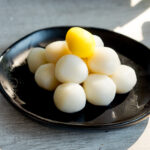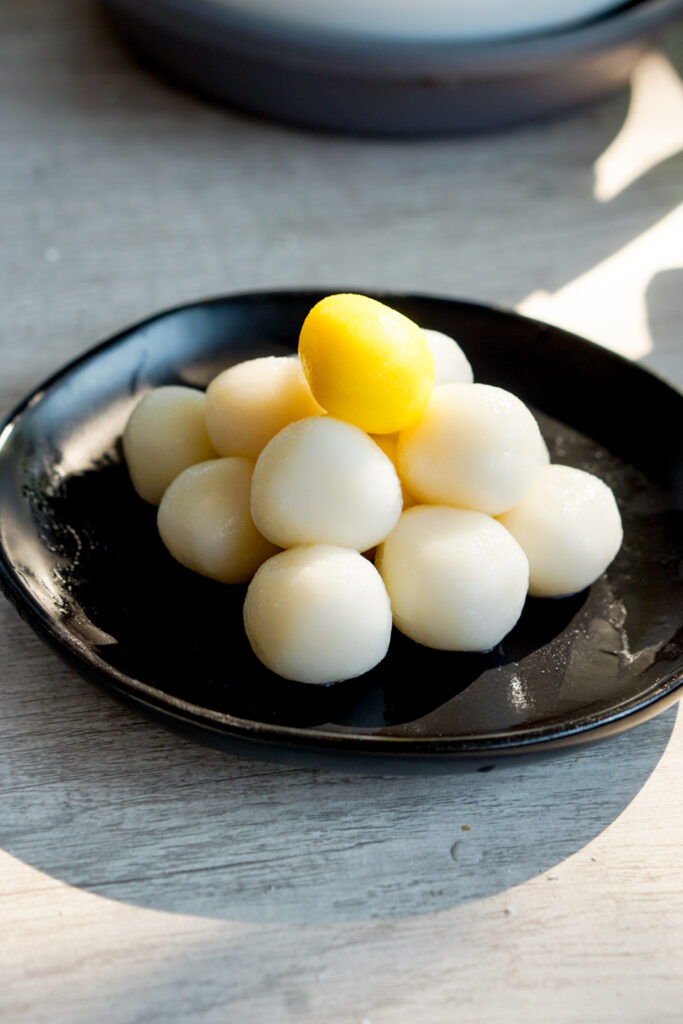Learn the easiest way to make tsukimi dango for Juugoya, the Japanese version of Mid Autumn Festival. Tsukimi dango are little rice balls that you eat while you watch the Harvest Moon. It’s easy enough that little kids can help and a fun way to get involved with Japanese culture.
Celebrating the Japanese Mid Autumn Festival
Hello, Mochi Momsters! By the time you are reading this, the mid autumn festival for 2022 will have already been at least a month ago. Oops. But the glory of the internet is that this recipe will still be around by the time the next mid autumn comes around…and the next.. and the next. So whatever year it is for you, welcome!
(Side note: I have never used the term Mochi Momsters before. I can’t decide if I love it or hate it. If you have a better idea, other than the Jane Eyre style “Dear Reader,” please let me know.)
Anyway, I wanted to make a little post about celebrating the Japanese version of the mid autumn festival in a way that’s easy for even preschoolers to participate. Many of you may know about the mid autumn festival from China, where it is a HUGE holiday filled with mooncakes and other fun treats. Korea also celebrates a version of this called Chuseok. In Japan, they celebrate Tsukimi, which means “moon viewing.” Tsukimi falls on Juugoya, which translates to the fifteenth night, as the festival is on the fifteenth night of the eighth month in the lunar calendar.
To celebrate Tsukimi, you eat fall-themed foods, decorate with fall themed decor (like pampas grass), and enjoy watching the full Harvest moon. One such fall-themed food specifically for Tsukimi is tsukimi dango!
What is Tsukimi Dango?
Tsukimi dango are small, chewy rice balls eaten specifically on Tsukimi. Actually, small chewy rice balls describe a whole category of Japanese treats called “dango.” They are similar to mochi, but use a combination of different rice flours. In contrast, mochi is made solely from pounded mochi rice (mochikome). For more information on mochi, check out my Ultimate Guide to Mochi post! Tsukimi dango is specifically eaten for this moon viewing festival because the little dango rice balls look like the full moon.
To make tsukimi dango, you mix the rice flours with water until it resembles a soft dough. Separate them into pieces, roll them into balls, and put them in boiling water to cook. Usually you display tsukimi dango in a stacked pyramid, along with your other fall seasonal decor. Then you eat them as you enjoy the full moon!
To be honest, though, I am not really a fan of eating food that’s been sitting out in the open for a long time. Some families leave it for a few days, letting the tsukimi dango get hard. Then they toast the dango to eat them afterwards. Personally, I prefer letting them sit on display for only a few hours and then eating them the same day it’s made. It’s up to you, though!
The EASIEST Tsukimi Dango Recipe
What makes my tsukimi dango so easy? I use premixed dango flour, called dangoko. You can buy these premade flour packs at a Japanese market. It even comes with a recipe for tsukimi dango on the back! All you do is mix the flour with water at the ratio listed on the bag. Roll into little balls, and boil for 3-4 minutes. That’s it!
Unfortunately, I have not been able to find this same dango flour on Amazon. If you don’t have a Japanese market near you, you may need to make your dango flour from mixing rice flours. It’s not THAT much harder, but it does require you to buy a few different types of rice flour. One is joshinko, which is made from regular rice (not the sticky mochi kind). The other is shiratamako, which IS the kind of flour made from mochi rice. Both of these are sold on Amazon, but they’re a lot more expensive than when I buy them in person. If you get your hands on them, you can use a half and half mixture of the two flours to substitute for the same amount of dango flour.
Other than that, this recipe is so simple right? Rolling the little dango balls is just like playing with play-dough! My four year old can even do it. If you’re looking to involve your family in celebrating Japanese holidays, this is a great activity to start with.
How to Stack Tsukimi Dango
The only tricky part of this whole recipe might be stacking the dango. If you try to stack your dango straight from the water, they will be wayyyy to slippery. My advice: let the dango dry a little. You can even pat them down with a towel. You want the surface to be tacky. Then, as you stack your dango pyramid (9 balls on the bottom, then a layer of 4, then 1), take a moment to hold each layer together with your hands, pressing the dango sides into one another. That should help them stick!
Eating Tsukimi Dango
A lot of friends I know eat tsukimi dango with sweet red bean paste. Remember that the dango itself does not have any sugar added, so they literally just taste like rice. My kids enjoy eating dango covered in kuromitsu, which is like a Japanese brown sugar syrup. It’s really easy to make (see my recipe), but you could use any other sweet topping you like!
That’s all I’ve got to say for this recipe. I hope you enjoy it! Do you have other ways your family celebrates the fall Harvest moon? I’d love to know!

Easiest Tsukimi Dango Recipe
Ingredients
- 125 g dango flour
- 100 mL water
- yellow food coloring See note
- ice water for cooling
Instructions
- Set a pot of water to boil while you prep the dango.
- Mix dango flour and water until it forms a soft dough.
- Divide into 16 equal portions and roll each portion into a small ball.
- Add 1-2 drops yellow food dye to one of the balls and knead thoroughly to incorporate the color. Reshape into a ball.
- Place all 16 dango into boiling water. Cook for 3-4 minutes, or until all the dango are floating. (After dango are floating, I sometimes like to let it boil for an additional minute to be sure it's cooked through)
- Strain dango and place in ice cold water to let it cool down.
- Strain dango again and gently pat until somewhat dry and tacky.
- Stack the dango into a pyramid: 9 dango in a square for the bottom layer, four dango on the next layer, and the one yellow dango at the top. If your dango are too slippery from the ice bath, they won't stack. You may need to let them dry more or hold them together with your hands until they stick.
- You can set your dango pyramid to display at room temperature for a few days to celebrate the Harvest Moon, or you can eat them before they get too hard. Even after they get hard, you can still toast them to eat (but I personally just don't like eating old food that's been sitting out). Dango can be eaten plain, with red bean paste, or with other toppings of your choice.

